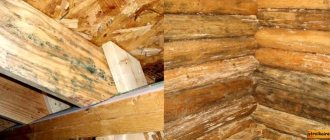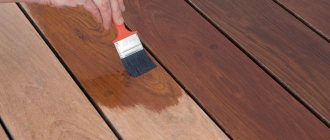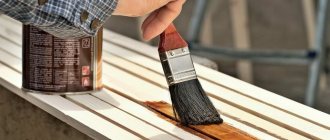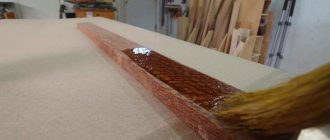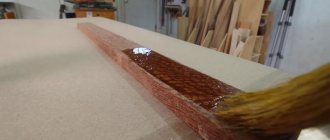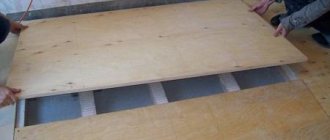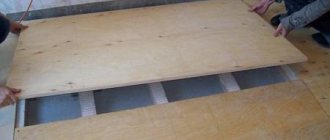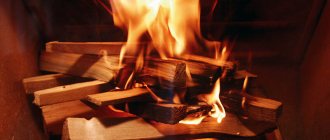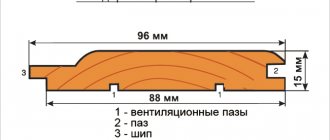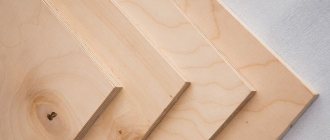Epoxy resin is considered a unique building material, since its scope of application covers not only industrial areas. Until a few decades ago, epoxy was used exclusively as a direct-use adhesive and as a binder filler in composite materials. Today, compounds are in high demand; these are specially developed grades of resins for pouring work. With their help, various products are created that have an original aesthetic appearance, but at the same time are quite practical. Resin, as the main material, is in demand in the production of furniture, pouring floors, making jewelry, and even in creating artwork.
If epoxy cannot yet compete with cheaper materials in cabinet furniture, such as chipboard, fiberboard or PVC, then it is simply ideal for countertops or panels. Its transparency often lulls consumers into misconceptions. Associations with glass indicate its fragility and low strength. Meanwhile, solidified resin arrays are highly resistant to mechanical loads. The glossy surface is practically resistant to impact and is slightly susceptible to abrasives. Transparency allows the use of various decoration technologies, in particular decoupage.
When working with epoxy resin, a high degree of responsibility is required from the master, and this should manifest itself not only in the process of pouring the compound. Already at the stage of choosing a material, you will have to approach the issue seriously. The problem is that this or that brand of resin is not marketed as epoxy resin for pouring countertops. Therefore, you need to be able to choose material, even if you come across completely unfamiliar brands and modifications. The success of the choice depends on theoretical knowledge of the criteria fundamental for pouring countertops.
Peculiarities
The store will likely stock a number of two-component compounds consisting of a base material and a hardener. In this form, epoxy is most suitable for work. Before mixing, the components remain in liquid form for an indefinitely long time, which means that the master can begin preparing the composition and pouring it when it is convenient for him, without time restrictions.
During the polymerization process, the compound retains its volume without shrinking. The transparency of the resin does not change when exposed to ultraviolet radiation, so the countertops retain their aesthetic appearance throughout their entire service life. The fluidity of the resin allows you to decorate the tabletop slab in a variety of ways. Despite the strength of the material, the resin can melt when exposed to high temperatures. Surfaces cannot be polished or ground using an angle grinder.
The cost of epoxy resin is difficult to estimate objectively. For one kilogram of compound you will have to pay from 700 to 1500 rubles, depending on the brand and manufacturer.
If we compare the cost of production with the cost of the finished product, the material turns out to be relatively inexpensive. Alternative options exist, however, in order for them to have similar strength, waterproofing, and durability, additional processing will have to be carried out, which will entail an increase in costs.
Epoxy resin performs several functions at the same time. In addition to creating a transparent surface, it serves as a material to stabilize the wood. The compound not only covers the wood from above, but also penetrates into the smallest pores. By the way, if photographs, natural materials, or plant flowers are used as decoration, then under a layer of epoxy they remain in their original form for a long time. Some designers see shading as a way to preserve family photos.
The potential of resin in artistic creation should also be appreciated. By varying the color, the master can create an imitation of bodies of water, the starry sky, and flora. Ideas of an abstract nature are also interesting. By adding a phosphor to the composition, luminous elements are obtained. In addition, the dielectric properties of epoxy make it possible to install electrical circuits for lighting. LED strips are usually used as a light source.
Useful to know > What is epoxy resin, how did it come about and how to work with it
Helpful advice
It happens that a piece of wood chosen for preservation or a product made from it has a defect in the form of a crack, loss of part of the wood structure, or some other defect. Moreover, it does not seem to spoil the appearance, but the presence of this defect is fraught with further destruction of the craft due to the possible penetration of pathogenic flora or even just water, from which the tree will swell and lose its shape, if not collapse at all.
Then, based on the color of the wood and its structure, you can radically fill the defect with a large amount of resin. It will look like ice frozen in a crack (if you paint the resin with a transparent dye in a bluish or greenish color) or like natural tree resin (if your wood is softwood, and the epoxy you poured into the crack was painted yellowish). It could turn out pretty good.
Moreover, for the second case, not even the expensive epoxy resin used to create designer furniture is quite suitable, but ordinary epoxy glue, the price of which is super affordable, and the packaging is very convenient, from 50 to 200 ml, you can choose any in the store. There will be no need to paint it yellowish; the adhesive compounds acquire a rich yellow color after some time.
Only if the natural flow of natural coniferous resin is imitated, it will need to be done in several stages: one droplet thickens, wait for time for this portion to completely harden, and only after a day will it be possible to form a second one. In this case, the glue can be heated to a critical temperature to quickly set and form resin droplets of the intended shape. Moreover, the diluted portions of epoxy in this case will be minimal.
Advantages and disadvantages
No material can be called absolutely perfect. The user only chooses which advantages are decisive and which disadvantages he is willing to neglect. Epoxy resin is no exception in terms of material for making furniture, in particular countertops. Some of the properties described earlier can be considered advantages, but they may not be so obvious in context, so here is a more specific list of the pros and cons of the resin. They will help the master choose the right brand, because minimizing shortcomings is on the list of his priority tasks.
- The polymer does not shrink. In this regard, everything is extremely simple. Whatever brand of resin the master chooses, he will be able to avoid shrinkage, since this unique quality is inherent in all types of epoxy resins, regardless of the hardener.
- After pouring the resin, due to its fluidity, it forms a smooth surface. Experienced craftsmen advise using more viscous compounds for the production of jewelry and souvenirs. As for filling countertops, preference should be given to material with low viscosity. The resin should penetrate into the corners of the mold, as well as fill all the cavities of the decorative fillers.
- It is recommended to handle the surface with care, however, it is quite durable. It is not susceptible to chips and cuts, and recommendations are given to reduce risk factors.
- Epoxy tables can be installed in any room. The resin is resistant to moisture, because in industry it is used as a material for waterproofing. This is a very important property, since in the kitchen furniture experiences temperature changes and high humidity.
- The transparency of the resin does not decrease even with prolonged exposure to sunlight. Here the compound looks more advantageous compared to plastic, which turns yellow, cloudy and cracks over time.
- Finally, it is necessary to note the variability of color design. The high degree of polymer adhesion allows you to create various design projects, both in terms of filling and color.
Now let's move on to the disadvantages. They also need to be taken into account when choosing a compound.
- One of the requirements is strict adherence to the proportions of the main component and hardener. This drawback will not in any way affect the procedure for selecting a brand of resin, since all manufacturers impose such a requirement on users.
- If modern jewelry resins are safe even in a liquid state, then when working with epoxy for countertops it is necessary to follow safety rules and use protective equipment. Cured resin does not emit toxins and does not harm health.
- When the resin is cooled sharply during its polymerization, suspensions in the form of flakes are formed, so it is necessary to strictly observe the temperature regime. Usually the resin is preheated to 50°C degrees, but if the flakes appear due to the low temperature in the room, then the finished tabletop needs to be heated and cooled in a less intense way.
Requirements
It should be noted right away that you won’t be able to save on material. Those resin modifications that are low cost are unlikely to be suitable for creativity, since they do not meet the requirements presented below. Among the technical parameters, the minimum layer thickness is of practical importance. No craftsman needs instant hardening of the resin. After pouring, the compound should have time to fill all the cavities, and air bubbles should come to the surface.
In addition, if there is decor, you may need to make some adjustments to its placement. If you take resin in a volume less than recommended, it will begin to set very quickly, which will negatively affect the quality of the product. As a rule, the first layer of resin is used to fix the decor at the base of the tabletop.
The most important parameter is the maximum layer thickness, which varies from 1.5 mm to 6 cm, and in rare cases more.
Many beginners prefer to choose brands of resins that allow them to fill the countertop in one go, but there is a certain nuance here.
- Firstly, layer-by-layer filling allows you to create three-dimensional images when decorating each layer.
- Secondly, the large volume of resin that has to be poured at one time can cause intense heat generation during curing.
Good to know > Transparent South Korean epoxy resin Ker-828
If the master decides to opt for a resin with a maximum layer thickness of 5-6 cm, then preference should be given to those models that have a long lifetime, because it guarantees a low reaction rate of the interaction of the components.
Typically, final curing takes about a day. However, you need to read the instructions to clarify this parameter. The fact is that the next layer can be poured only after the previous layer has completely cured. The remaining selection criteria are related to the cost and popularity of the manufacturer. If the cost is very easy to determine, then the rating of manufacturers and suppliers will have to be studied additionally. It is useful to take advantage of the advice and tips of experienced craftsmen. We will give several examples of popular brands that, in all their parameters, meet the requirements for filling countertops.
Review of popular brands
The list below is not absolute. The popularity of epoxy resin brands is determined according to reviews from real customers. Naturally, different interpretations of reviews can be found in different sources. However, the above list is quite enough to start your creative and artistic activities without proper experience.
- QTP-1130. This brand is positioned as a resin for pouring countertops. It’s safe to say that this is a universal option for beginners who do not want to go into details of the technical characteristics of the material. The maximum layer thickness is about 3 mm. Pouring in one step is possible only if there is decor made of wood, stone or slab. The resin is transparent. It does not get a yellow tint after curing, so the tabletops are decorated with pictures or photographs. Low viscosity promotes self-leveling. QTP-1130 is most often used in the manufacture of coffee tables or small desks.
- Art-Eco. The research and production facility is engaged in the development and production of epoxy resins for household use. All products are released under the Art-Eco brand. The attention of buyers is attracted by the variety of accessories. In addition to the main material, the buyer is offered a huge selection of colors and pigment pastes. A solvent for epoxy resin has also been developed. It is used when necessary to reduce the viscosity of the compound. The resin is distinguished by its suitability for pouring thin layers. The maximum layer thickness does not exceed 5-7 mm. In general, reviews about this model are positive, but there are some negative points. The material is very demanding in maintaining proportions. The slightest deviation from the recommended values leads to incomplete curing or an increase in viscosity. In conditions of forming a flat horizontal surface, this is unacceptable. In addition, many craftsmen complain about the appearance of a yellow tint, although it is barely visible in the light. It is recommended to use the resin in conjunction with any color.
- ED-20. This brand of resin is causing endless controversy in various forums. She has her fans and critics. It must be admitted that ED-20 is considered a classic, since it is the only resin on our list produced in accordance with GOST. By the way, its name is also written in the specified document. It no longer meets modern requirements. High viscosity causes air bubbles to appear that do not have time to reach the surface. The master has to make extra efforts to get rid of them. It is also noted that the transparency of the compound decreases over time, and the polymer itself acquires a yellowish tint. The model has several modifications that are characterized by increased strength, but they are more in demand for pouring floors in technical rooms. ED-20 does not lose its popularity only due to its low cost. It is this quality that is valued by those who decide to try their hand and gain the necessary experience before performing more jewelry work.
Useful to know > Contact brand two-component epoxy adhesive and its varieties
- CHS Epoxy 520. There is not much to say about this model. All you need to know is that it is perfect for the most difficult jobs. Complexity refers to the presence of decor made from natural materials in the tabletop. The compound goes well with the herbarium, and there are no difficulties when pouring it. It is known that viscous resins have a mechanical effect on dry flowers and plant petals, as a result of which the decor has to be leveled. CHS Epoxy 520 resin in combination with 921 OP hardener has high adhesion. The tabletop can be decorated with metal, wood or plastic. The material from the Czech manufacturer is called an improved analogue of ED-20. Indeed, this resin is devoid of the shortcomings that were inherent in the model that appeared in Soviet times. An important quality is the absence of boiling even when filling large volumes.
- Crystal Glass. Crystal Glass resin is produced in the city of Yaroslavl. It is sold in plastic bottles of 200 g. The kit also includes a hardener. This resin has high fluidity, making it ideal for filling large areas. But with the proper technique, it can be used as a jewelry compound. It is necessary to gain at least basic experience in order to vary the viscosity. After mixing the components, the resin is infused for some time, and its viscosity increases. The master's task is to determine after what time pouring should begin.
- PEO-610KE. This brand of compound, like ED-20 resin, is certified according to GOST. The letter “E” in the name indicates that the material is elastic after curing. For the production of countertops, this property is of great importance. Elasticity allows you to distribute the load under mechanical stress. The resin's lifetime is 4 hours, and complete curing occurs 54 hours after preparing the composition. Resin is in the middle price category. For 150 grams of the main component you will have to pay about 600 rubles. The hardener for PEO-610KE must be ordered separately from the manufacturer. It is suitable for all modifications of resins of this brand.
- EpoxAcast 690. EpoxAcast 690 resin is presented by Russian. It is positioned as a compound for making jewelry. As a material for countertops, the brand is interesting because it allows you to fill a layer of up to 5 cm. Unlike the previous model, this resin is not elastic. After curing, it shrinks slightly, but the transparency is not lost. The manufacturer simultaneously delivers the goods. For 1 kg of resin, the buyer will pay 2000 rubles.
- MG-EPOX-STRONG. German quality never fails. Many experienced craftsmen who work with MG-EPOX-STRONG write about this. Many master classes recommend filling countertops with this particular material. The only drawback that buyers could find was the long curing time. The resin product can only be used 3 days after pouring. The resin is called ultra-transparent and ultra-strong for its technical characteristics.
- Epoxy CR 100. Epoxy CR 100 resin has fairly high performance, so it is used as a universal material. The brand was included in the rating list not only because of its technical parameters. Epoxy CR 100 resin is harmless even in liquid state. Protective equipment will only be needed to protect items of clothing.
How to coat wood with epoxy resin, seal it and remove bubbles?
| Coating a wooden surface with epoxy resin is a task that has its own specific rules and typical mistakes. All efforts can be ruined by improper work planning. What difficulties may lie in wait for this?
Impregnation of wood with epoxy resinThere is also such a completely separate task as impregnating wood with epoxy resin. For impregnation, on the contrary, it is recommended to heat the wood (for example, with a hair dryer), then the resin applied to the hot wood will quickly become liquid and be well absorbed. We mention this method here because a combination of both is possible. If you have time to work in two layers (which will take 2 days, taking into account the curing time of the resin), then a more reliable solution may be to first saturate the surface with a small amount of resin with heat, thereby “sealing” the pores, and then apply the finishing layer with the second layer coating. Keep in mind that in this case, the second stage of work must proceed in full accordance with the recommendations from the first part of the article - after all, we are not 100% sure that we managed to close all the pores. This recommendation is similar to the technique when, before applying the main layer of self-leveling floor, the concrete screed is primed to seal the pores and reduce material consumption (more details here). Removing bubbles in epoxy resinIf bubbles appear, do not try to remove them by heating. This will force new bubbles out of the wood, and it will be even more difficult to correct the appearance of the coating. If there are only a few bubbles, you can try to puncture them with a needle or toothpick. Numerous bubbles can be removed by spraying a little alcohol over the surface. Before using this method, you should test it on an inconspicuous area: the alcohol can cause the epoxy resin to become milky in color and appear different from the untreated surface, especially if you are using epoxy resin pigments. For large bubbles that are discovered after the resin has hardened, the only method left is drilling, sanding the edges and re-filling, which is quite labor-intensive and time-consuming. It is easier to plan the work well in advance than to correct such a defect. Back to the directory To the section “Epoxy resins” |
ru-smola.com
